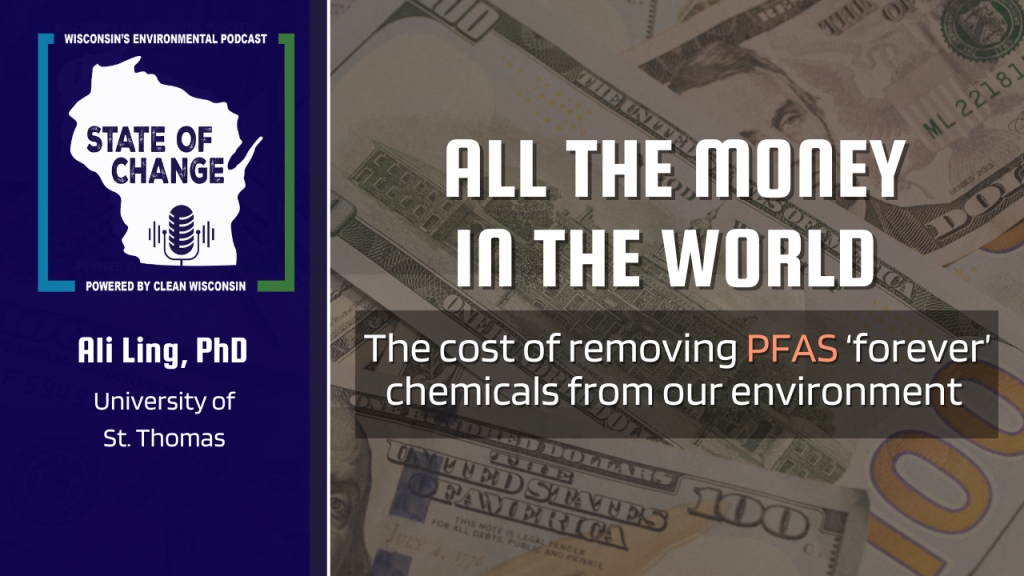New research reveals how much it would cost to remove toxic PFAS ‘forever’ chemicals from the environment at the same rate we’re currently producing and using them. Spoiler alert: we don’t have enough money in the world. Hear from the researcher behind the study who says it should inspire optimism not hopelessness in the face of our growing PFAS problem.
Host:
Amy Barrilleaux
Guest:
Ali Ling, PhD, University of St. Thomas
Background Reading:
The Future of Persistent ‘Forever” Chemicals
Under the Lens: What we know about PFAS in Wisconsin’s drinking water
Toxic PFAS pollution devastates two Wisconsin Communities (video)
Where to Listen:
Transcript:
Amy: Look around you. The comfy chair you’re sitting in, the shoes you’re wearing, the carpet, the airfryer and nonstick pans in your kitchen. Chances are it all contains PFAS, also known as ‘forever’ chemicals. There’s growing evidence that the chemicals pose real health risks, but they’re still everywhere. Widely produced and used in all kinds of consumer products. In this episode, what will it take to clean up all that PFAS? I talk with a researcher who put an eye-opening price on our addiction to ‘forever’ chemicals. I’m Amy Berrilleaux, and this is State of Change from Clean Wisconsin. PFAS are called forever chemicals for a reason. They don’t break down in the environment. They stick around in our bodies, waterways, soil, sediment, air, plants, animals. And that makes cleaning them up daunting. Joining me is Doctor Ali Ling, assistant professor of civil engineering at the University of Saint Thomas in Saint Paul. You’ve done some research around PFAs cleanup, but first, what made you start looking into these contaminants in particular?
Ali: I am at the University of Saint Thomas now, but just before this I spent about ten years in engineering consulting. And when I was working in consulting, I worked mostly for, you know, municipal water treatment plants or industrial wastewater treatment plants. And as I went through that ten years in consulting, there was an increasing focus on particular clients needing to deal with PFAS. So I started helping people with PFAS treatment plants, over the last five years or so. And then when I switched into academia, I wanted to take that focus into my research work.
Amy: For people who may not know, PFAS have been found in a lot of water systems all across the country. How do you get them out of water?
Ali: They’re a little bit challenging to get out. So the the thing there’s a couple of main things about PFAS. They are very persistent, which means that they’re hard to break down. That means they don’t break down naturally in the environment. But it also means when we engineer things that we try to destroy them, they take a lot of energy to break down. The other thing is that PFAS are very mobile and water soluble, so they like being in the water. So if we’re trying to get them out of water so that they’re not in our drinking water, you have to use kind of specialized methods to do that. So the typical way to get them out of drinking water is to use, a big tank that’s full of granular activated carbon. And what that is, is it’s like it’s like a kind of if you took fancy charcoal and you crushed it up to the size of sand, you put it in these big tanks and then you run water through it, and then the PFAS sticks to the carbon for a while, and it it kind of sticks to the carbon until there’s too much that stuck on the carbon. And then it starts passing through. So it works really well. But you have to pay attention to the point at which there’s too much of it on the carbon, and then it doesn’t work anymore.
Amy: So PFAS can be removed from water. And that sounds pretty good. But what are the big picture problems with that from your perspective?
Ali: Yeah, there’s a couple main problems with it. The first is that, it’s pretty expensive to do, so, our drinking water treatment plants typically don’t have this level of treatment in them. In order to put water through that type of filter, it needs to be relatively clean. You have to build these extra tanks. You have to pressurize them. They use the energy to pump them through. And then, probably the biggest cost associated with it is you need to change out that media once it’s all used up. So once it’s all full of purpose, you basically need to take it out of the tank, send it somewhere and put new stuff in the tank. And so buying the new stuff is expensive, and then sending it somewhere where it’s actually disposed of in a responsible way is also expensive.
Amy: So once you came over to academia to the University of Saint Thomas and you thought, I want to look at something related to PFAS forever chemicals that are, you know, all around us all the time and still being manufactured. You decided to look at the cost of getting rid of these chemicals. What exactly did you look at?
Ali:] Yeah. So I teach environmental engineering. And one of the things that environmental engineers are concerned with is like, in a system, what comes in and what comes out. And so, we think a lot about like, what we call steady state systems, which are systems that, are kind of balance, like there’s the same amount of stuff coming in as going out. And that’s kind of the way that you want things to work. It’s the way we want, you know, the things we’ve built to work. And it’s also ideally the way we want the globe to work if we’re going to live here long term. So, I was interested in looking at PFAS, but specifically looking at costs to keep the world at like a steady state for PFAS. One of the issues with fast is that we make a lot of them, and because they don’t degrade in the environment naturally, any PFAS that we put out there is basically just building up and building up and building up. So if we continue to make them and use them, the concentration and the amount of PFAS in the environment just goes up forever, it doesn’t go away. So when I wanted to look at cost, a lot of people are looking at cost of water treatment and cost of specific applications. What I really wanted to understand was the cost of managing us in the environment of the globe as a whole.
Amy: When you say managing PFAS in the globe as a whole, you’re talking about in the air, in the soil, in the water, in the everything. And you found that the amount of money it would take to do that would exceed the global GDP, which is the national income of every country in the world. It’s it’s all the money in the world. Explain how you got to this number that exceeds the global GDP.
Ali: Yeah. So I’m kind of thinking about like all the PFAS out there in the world. In in again in the air, the soil, the water. I think about that. It’s like a bathtub. And if you think about the PFAS that we’re making and putting into the environment, that’s like the the water coming into the bathtub, and then if we think about the fact that we’re actively removing from the environment and destroying it, that’s like the drain of the bathtub. So right now the bathtub is super unbalanced. It’s being filled very quickly. We’re making like millions of tons of PFAS every year. But the drain to remove it is very small. Like we we don’t have the capacity or the funds to remove it at a similar rate to the what we’re putting into the environment. And so that was my study is I was trying to ask if we’re trying to remove PFAS from the environment at the same rate that we’re currently putting in to get to that steady state level. How much would that cost? And that’s where I got to this number that exceeds the global GDP.
Amy: What does that mean in the battle to get these chemicals under control?
Ali: Yeah. That means that we cannot afford to remove PFAS from the environment as fast as we’re putting it in. So if we want to have a place where PFAS aren’t continually increasing in the environment, and I think we should want that because I would like to have humans living on the planet in, you know, 200, 500 years. If we want that, then we can’t focus on draining the bathtub. We can’t focus on the remediation and treatment side. We need to focus on reducing the emissions, how much PFAS we’re making, using and putting out into the environment.
Amy: So when you looked at the cost to, you know, keep us at that kind of static level of PFAS, where are you looking at actually destroying the PFAS, like breaking it down into its constituents?
Ali: Yeah. And in the cost that I used all included that destruction step. And that’s a really important aspect of when people talk about treatment or remediation, it’s really important to ask whether it includes a destruction step. So there’s a couple of different types of treatment and remediation. You see some of them, it takes it out of the water. And then you might just put it right back into the environment. So a lot of drinking water systems have like a reverse osmosis. They remove it from the water that’s going to drinking water, but then it just goes right back into the environment. There’s some PFAS treatment that it puts it into, maybe a solid phase and you might burn it and it might go also right back into the environment, into the air. So treating PFAS, if you’re not destroying it, it’s going to be relatively cheaper than treating it with the destruction step, which is really the environmentally responsible way to manage PFAS.
Amy: And destroying PFAS, if I’m not mistaken, takes a lot of energy because those bonds that hold its molecules together are really, really strong. What does it take to really break it apart?
Ali: Yeah, it is very energy intensive and we call it a forever chemical because it lasts forever in the environment if we don’t do any about it, anything about it. But that doesn’t mean that we can’t destroy it. We can destroy PFAS if they’re heated up. The amount of heat it takes to actually destroy most PFAS and turn them into things that are not PFAS is typically around 1000 degrees C. Now, the clean cycle in my oven is like 500 degrees C, and I think that’s pretty hot. So if you’re getting up to 1000 degrees C, it takes a ton of energy, a ton of cost, uses a ton of fossil fuels and puts out a lot, a lot of CO2. But B, there’s not very many places that do that. There’s only about 20 facilities in the United States that get things that hot to actually destroy and de-fluorinate the PFAS.
Amy: When you’re talking about water treatment, for example,with activated carbon, those big filters, what happens? Do they just go to a storage facility somewhere?
Ali: So, so they filter it onto the activated carbon. And then you have to change out the activated carbon. What you do with that kind of depends on the facility. A lot of them are just sending them to a landfill right now. So a landfill is kind of a medium term place to put stuff. So you put it in the landfill. But over time, PFAS come out into the liquid that seeps out of the landfill. And sometimes that can be collected or treated or sometimes that’s treated, you know, sent to the wastewater plant and sent back to the environment. The landfill is also, a recent study just found that landfill gas is a big source of PFAS. So a lot of the stuff that we use that have PFAS, including the spent media from water treatment, goes into landfills and the PFAS can escape from the landfills in the gas because it’s such a mobile chemical.
Amy: We’ve been producing PFAS since the chemicals were invented in the 1940s, not even 100 years ago. And here we are today with a lot of PFAS in a lot of places. So when you look at what happens if we don’t stop putting PFAS in that, you know, bathtub as you painted that picture, what happens if we don’t make a real difference in that?
Ali: Yeah. And I just want to say, like, I don’t feel like at this point we have a lot of PFAS in a lot of places. I think there are some places in the world that have a lot of PFAS in them as a result of specific industrial pollution. I think most places in the world have a little PFAS and it’s, you know, somewhat worrying. But at this point, for the current people living today, it’s probably not a health crisis right now for most people in the world. But because it doesn’t go away, it’s going to keep building up. So if let’s say, you know, we’ve used PFAS for less than 100 years now and the is the rate of them have, it’s hard to say exactly if we’re using more PFAS now than we were before, because we’re using different types of PFAS. But generally the rate of their use has probably been increasing over that time. If we continue to make them at the same rate we’re making today, or even worse, at an increasing rate, the amount of PFAS in the world kind of throughout the world is going to continue to increase at accelerating rate. And so if people are worried about the health effects to people now, you know, the health effects to people 100 years from now are going to be significantly higher, because we’ll have made a lot more fast in that time and probably emitted a lot more fast.
Amy: So you came out with this study, that I think was, you know, eye opening for a lot of people, that showed we don’t have enough money in the world to destroy the amount of PFAS that we’re putting into the environment right now to kind of keep things even in terms of the pollution we have currently. What was the reaction when you came out with that study?
Ali: You know, the reaction that I got from a lot of people was not the reaction that I intended. A lot of people saw the study and just felt kind of hopeless, like, oh, there’s nothing we can do about it. Whereas what I intended was the opposite. My intent was to inspire hope and action in reducing how much PFAS we’re putting into the environment. So it was meant to just really shift the focus from, you know, we’re going to treat all the PFAS in the world. And that’s the answer. No, that’s not the answer. We cannot afford to do that. It’s out there. It’s just once it’s out there in the environment, it’s so difficult to remove because it gets so diluted. So let’s turn around and focus on the PFAS we’re making reducing how much we’re emitting with the PFAS that we’re making. And in places where we don’t need to use as much people. Let’s not use that in those applications.
Amy: You’ve touched on in some of your writing and discussions, where do we go from here? You know, first, in terms of protecting yourself and your kids or your family, what are the steps that you would advise people to take?
Ali: Yeah. So in terms of the PFAS that people get into their bodies, people talk a lot about drinking water, but drinking water accounts for less than 10 or 20% of how much people, most people, get into their body. So the PFAS that gets into your body is mostly from food that you eat. There’s PFAS in a lot of pesticides, there’s PFAS in a lot of food packaging. And also from dust in your house that you breathe in, in your house and work with. So most of those things are related to stuff that we buy. So in order if you want to protect yourself and your family from, PFAS exposure right now, the best things to do are to look up PFAS-free products and brands and try to buy from those things. Especially for things that are contacting your skin. So things like cosmetics, like sunscreens. Like food packaging, things that you’re eating. You know, if foods, if you can buy foods that aren’t made with pesticides, that would be an advantage as well. So really kind of focusing on what you’re purchasing and if you can purchase them for free.
Amy: Well I think PFAS-free is starting to get harder and harder. It feels like they’re getting put into everything. It’s one thing, you know to have them in firefighting foam for jet fuel fires, although there seem to be some emerging different types of chemicals that may be used for that. But if I look around this room right now, I can find all kinds of things that probably contain PFAS. You know, the cushion of the chair I’m sitting in, I have a skirt on that appears to be somewhat water or stain resistant for some reason. My shoes are water resistant. So it feels hard or next to impossible to get PFAS out of your life. There is no labeling requirement. You have to be like a detective to limit your exposure.
Ali: Yeah, PFAS are in a lot of things we use and I, I hope that this, like consumers, should be aware of what they’re using. But I’m hoping that that consumer vigilance on PFAS is kind of a short term thing as we phase them out of consumer products. So there are, laws in place now that are currently being enacted to phase out of products in certain states. The European Union has been working on restrictions as well. One of the important things about about the societal response to people is that we need to address fast as a class of chemicals, because they’re all persistent. A lot of the work by the United States EPA has focused on, you know, PFOA, PFOS, a couple others. So a small group of chemicals that we know the toxicity data for that we’ve had a lot of data for that have been around for a long time. And they’re focusing just on those specific PFAS. But there are millions of PFAS out there and they can all change into different types of PFAs into the environment. And they’re all persistent. So they’re all problematic. So one key thing about these legislations coming up is they need to address PFAS as a class. But what are some of the things that I think are being successful? For example, in the state of Minnesota where I live there is a use restriction that is currently going into effect. The Minnesota Pollution Control Agency is working hard on trying to figure out what that looks like and how it’s going to work. The the use restriction in Minnesota, it bans intentionally added PFAS from 11 specific product categories by the beginning of 2025. So that includes things like cosmetics, menstrual products, food packaging, firefighting foam, textiles, kids toys, things where there are alternatives to PFAS that are currently available that we can, they should be able to replace. And then by 2032, the goal in Minnesota is to ban all PFAS that are not currently unavoidable. So there’s a couple of a couple of complications in there. The first is figuring out what PFAS are intentionally added. PFAS are so pervasive in our supply chain that they’re in a lot of products that might not be there for a specific function. So I think understanding and sampling and collecting that data is something that we need to do. And the second is this currently unavoidable use issue. And you mentioned it a little bit with the firefighting foams. I think in a lot of firefighting foam applications we can replace PFAS with something else. But in others that are very high hazard, maybe we shouldn’t. And they’re used a lot in semiconductors. They’re used in some pharmaceuticals. So I think identifying the place where PFAS do more good than harm and keeping them in those places, at least for now, until we have the research and development alternatives to replace them.
Amy: So I guess, does the fight against PFAS need to go even higher to the actual chemical companies themselves that are producing these? I mean, you’re in Minnesota, the home of 3M that has faced lawsuits over PFAS, chemicals that it has produced and disposed of in the Twin Cities area. Is there any hope that regulations can happen that really target the manufacture of these chemicals?
Ali: That’s a good question. I think, you know, 3M for example, has promised to phase out all PFAS by 2025. I know that’s coming up. So I haven’t actually kept up on what the status of that is, but that’s that’s a good start. There are only like, you know, less than 30 companies in the world that are making PFAS at a big amount. And then it goes into the supply chain and into all the products that we use. So I think that could be a potential. But I think again, it it hinges on these, the currently unavoidable uses or sometimes called essential uses. If there’s places where we still need to keep making PFAS, like we probably still need them in some places. So I think it’s looking at the, the initial manufacturers of PFAS as well as the entire supply chain to understand where does all the PFAS come from and where is it going and where does it not need to be going.
Amy: So if somebody is listening to this and having the reaction that you didn’t exactly want people to have to your study where it feels overwhelming, you feel like I’m surrounded by all kinds of chemicals. Where would you tell them to begin?
Ali: Yeah, and that’s a good point. PFAS are just one of the environmental contaminants we face every day. And I can’t argue that it’s the most important environmental issue we’re facing today. But it is an issue. And I think the persistence of PFAS that it’s going to affect people a long time into the future. You know, I think from where to begin, phasing out PFAS from your own life is a place to start. I think talking about it with people you know, with your friends and family, I think talking to your representatives and senators about it. For example, in Minnesota, we have this PFAS ban in place, and there’s a number of other states in the United States where there are similar use restrictions coming online, but not in every state. So talk to your representatives and senators about it. There’s been some, legislation introduced at the federal level to try to get some PFAS use restrictions as well and supporting that, trying to get that through. One of the issues with these, these use restrcrions and laws is we don’t necessarily know how they’re going to go, how the reporting is going to go, how the determination of uses that are currently unavoidable is going to go. So I think it’s a little scary because the PFAS are you know, so pervasive in our supply chains. But we need to start somewhere. We there are places in our economy where we use PFAS and we do not need to use them. And let’s start there. If there’s places where we don’t need to use them, let’s just ban them and not use them there.
Amy: Doctor Ali Ling from the University of Saint Thomas, thank you so much for doing this research and for the discussion. I really appreciate it.
Ali: Yeah. You’re welcome. Thank you for having me.





